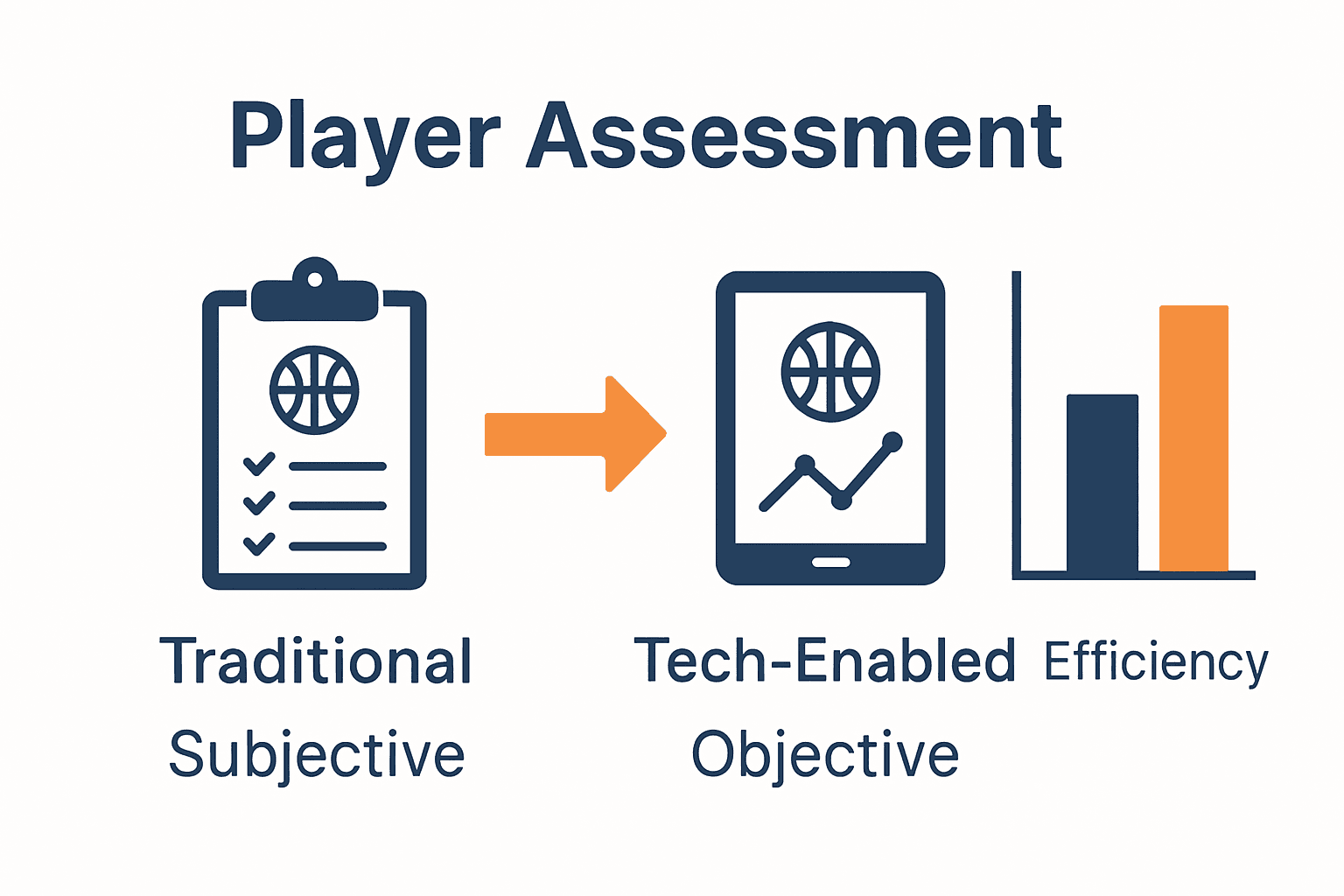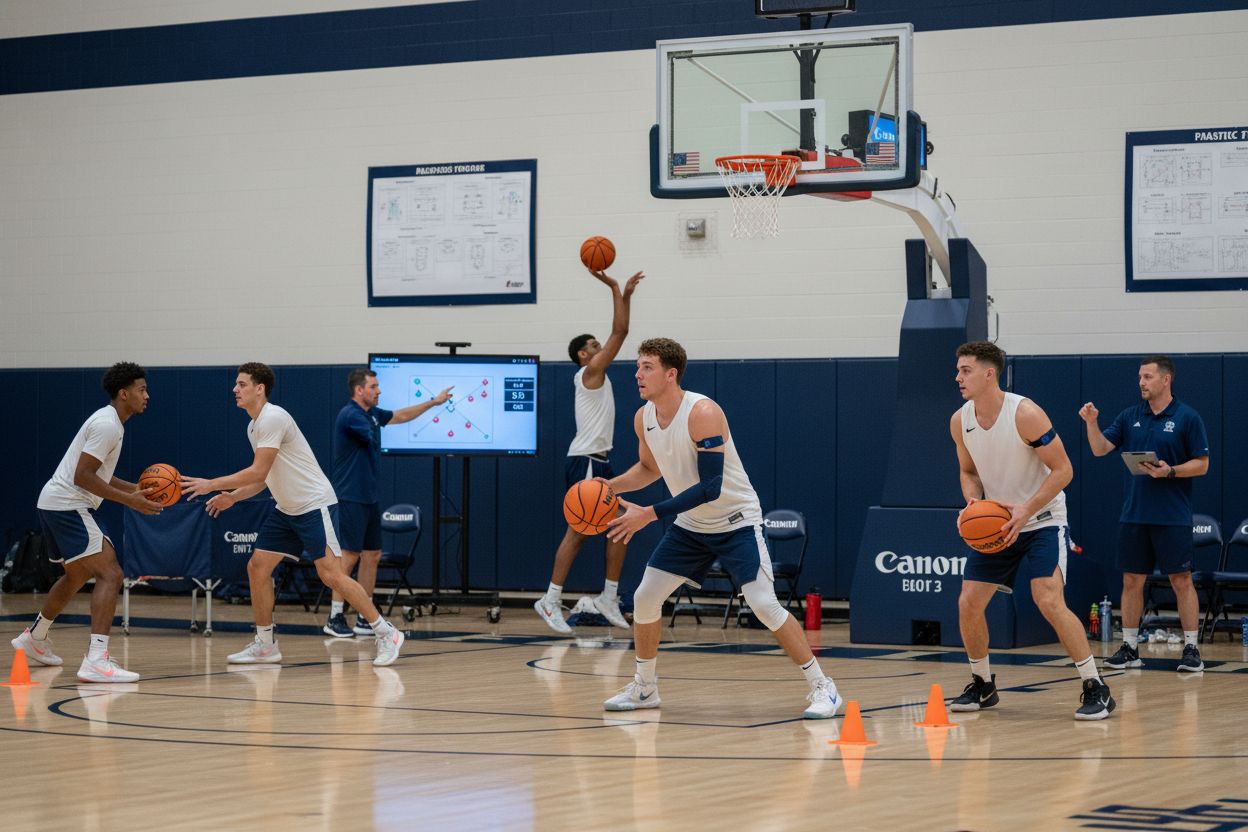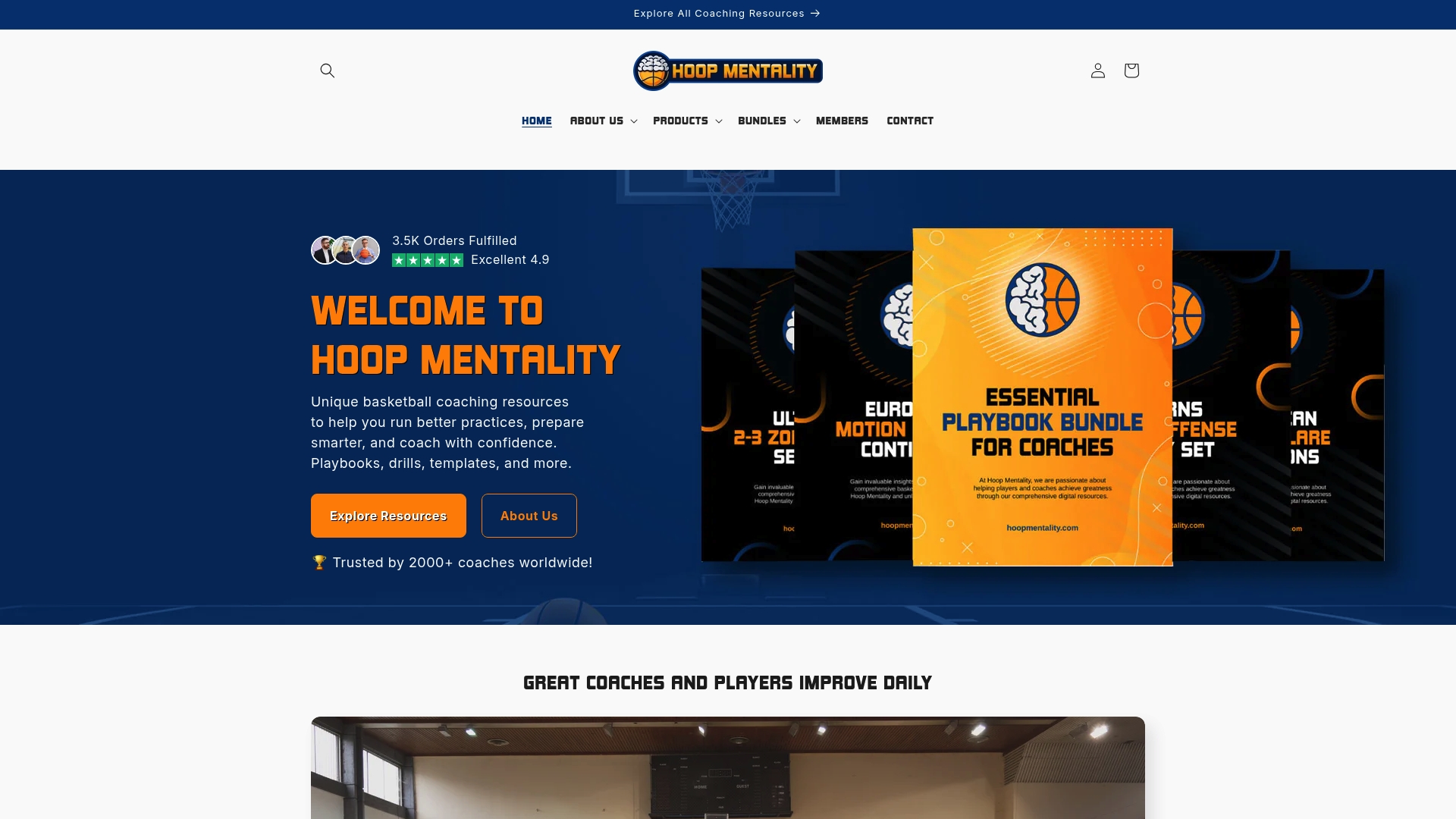Did you know that nearly 70 percent of basketball coaches now use tech tools to evaluate and develop their players? Understanding and nurturing skill at every level can make the difference between a struggling team and a championship contender. When you assess abilities, design smart practice plans, and build strong foundations, you cultivate players who adapt fast and think even faster on the court. This approach brings out each athlete’s full potential and sets any program up for real progress.
Quick Summary
| Key Point | Explanation |
|---|---|
| 1. Assess player skills objectively | Use comprehensive frameworks and technology for accurate evaluations, focusing on physical, cognitive, technical, and mental attributes. |
| 2. Create tailored practice plans | Develop customized training sessions based on player assessments, incorporating diverse activities that enhance skills and promote recovery. |
| 3. Focus on core skill mastery | Prioritize fundamental skills through consistent drills that build muscle memory and confidence in fundamental basketball techniques. |
| 4. Train decision-making under pressure | Utilize simulated game scenarios to enhance players’ ability to make quick, strategic decisions, fostering cognitive understanding of the game. |
| 5. Evaluate progress systematically | Implement ongoing assessments to track individual and team improvements, providing feedback that encourages growth and maintains motivation. |
Table of Contents
- Step 1: Assess Player Skill Levels And Needs
- Step 2: Structure Effective Practice Plans
- Step 3: Implement Foundational Drills And Skills
- Step 4: Develop In-Game Decision Making
- Step 5: Evaluate Progress And Reinforce Learning
Step 1: Assess player skill levels and needs
Evaluating your basketball players requires a strategic approach that goes beyond just watching them play. Think of this process like assembling a puzzle where each player represents a unique piece with specific strengths and potential areas for growth.
Start by creating a comprehensive assessment framework that looks at multiple dimensions of player performance. According to research from advanced video analysis studies, modern coaches can now leverage technology to obtain objective skill insights. This means moving beyond traditional subjective observations.
Your initial assessment should cover key areas:
Here’s a comparison of key assessment areas and example evaluation criteria:
| Area | What to Assess | Example Criteria |
|---|---|---|
| Physical Skills | Shooting Speed Agility |
3-point accuracy 40-yard dash Lateral shuffle time |
| Cognitive Skills | Game IQ Decision Speed |
Correct reads Pass timing |
| Technical Skills | Ball Handling Passing |
Turnover rate Assist count |
| Mental Attributes | Leadership Resilience |
Motivation Response to setbacks |
- Physical skills (shooting accuracy, speed, agility)
- Cognitive game understanding (decision making speed, court awareness)
- Technical skills (ball handling, passing precision)
- Mental attributes (leadership potential, emotional resilience)
Consider using video analysis tools that can provide granular performance data. Our guide on basketball evaluation criteria offers deeper insights into creating robust assessment protocols.
Pro Tip: Always combine quantitative data with qualitative observations. Numbers tell part of the story your direct interactions will complete.
Remember that player assessment is an ongoing process. What you discover in initial evaluations sets the foundation for personalized development strategies. Your next step will involve translating these insights into targeted training plans that address individual player needs.
By approaching skill assessment systematically and objectively, you transform raw potential into structured athletic development.

Step 2: Structure effective practice plans
Creating an effective basketball practice plan is like designing a strategic roadmap that transforms individual potential into team excellence. Your goal is to craft sessions that are purposeful engaging and scientifically informed.
Start by understanding your team’s specific needs based on the skill assessments you completed earlier. According to research using advanced wearable technologies, modern coaches can now design practice plans using objective physiological data that tracks player performance and recovery metrics.
Your practice plan should include:
- Warm up activities targeting specific muscle groups
- Skill development drills matching individual player needs
- Tactical training focused on team strategies
- Conditioning exercises that improve overall athletic performance
- Recovery and mental preparation techniques
Our basketball practice plan template can help you organize these components systematically. Consider integrating innovative training approaches like virtual reality simulations that can enhance players’ decision making skills under pressure.
Pro Tip: Balance intensity with recovery. Pushing players too hard can lead to burnout and potential injuries.
Modern training strategies are moving beyond traditional approaches. As cutting edge research on basketball training technologies suggests innovative tools can provide personalized feedback and create immersive learning experiences.
Remember that a great practice plan is flexible. Be prepared to adjust based on player responses and emerging team dynamics. Your ultimate objective is creating an environment where learning technical skills and building team chemistry happen simultaneously.

Step 3: Implement foundational drills and skills
Transforming basketball players starts with mastering core skills that become the foundation of their entire athletic journey. Your mission is to build a robust skill set that creates confident versatile players who can adapt to any game situation.
According to MasterClass’s comprehensive fundamentals guide, key skill areas include footwork dribbling shooting passing rebounding defense and jumping. Each of these components requires deliberate consistent practice to develop muscle memory and player confidence.
Start with classic drills that have stood the test of time. Take the legendary Mikan drill for example. This foundational exercise helps players develop crucial skills for scoring and rebounding near the basket by practicing close range layups with both hands.
Your fundamental skills training should focus on:
- Precise ball handling techniques
- Shooting accuracy from multiple distances
- Defensive positioning and movement
- Passing with speed and precision
- Rebounding with proper technique
Our skill improving infinite loop drills can provide structured repetition that transforms basic movements into instinctive actions.
Pro Tip: Emphasize quality over quantity. Perfect one movement before increasing speed or complexity.
Remember that skill development is a gradual process. Players need patience consistency and positive reinforcement. Break complex skills into smaller manageable components and celebrate incremental improvements.
Your next step involves creating progressive challenges that keep players engaged while steadily expanding their capabilities. By building a strong technical foundation you set the stage for advanced tactical understanding and team success.
Step 4: Develop in-game decision making
In basketball exceptional players are distinguished not just by physical skills but by their ability to make split second intelligent decisions under pressure. Your goal is to transform players from reactive performers to proactive strategic thinkers who can read the court like a complex chess board.
Decision making is a skill that can be systematically trained through structured approaches. Think of it like building a mental muscle memory where players learn to process multiple variables simultaneously and respond with precision.
Start by creating simulated scenarios that mirror real game conditions. These training environments should challenge players to:
- Quickly assess defensive and offensive positioning
- Recognize potential passing lanes
- Understand spacing and player movement
- Make rapid choices with limited information
- Anticipate opponent strategies
Our essential tips for first time basketball coaches provide additional insights into developing player cognitive skills.
Pro Tip: Use video analysis and game footage review to help players understand their decision making patterns and potential improvements.
Encourage players to verbalize their thought processes during drills. This metacognitive approach helps them develop self awareness and strategic thinking. Create an environment where making mistakes is viewed as a learning opportunity rather than a failure.
Remember that great decision makers are not born they are developed through consistent intentional practice. Your role is to provide the right mix of challenge support and constructive feedback that nurtures their cognitive basketball intelligence.
Step 5: Evaluate progress and reinforce learning
Successful coaching is about creating a continuous improvement cycle where players consistently grow and refine their skills. Your objective now is to transform raw performance data into meaningful insights that drive player development and team progression.
Modern coaching leverages technology to gain objective insights. Research using wearable devices and machine learning demonstrates how physiological metrics can provide coaches with precise understanding of training effectiveness and individual player progress.
Your evaluation process should include multiple assessment dimensions:
- Individual skill progression tracking
- Performance metrics from game situations
- Physical fitness and conditioning improvements
- Cognitive decision making capabilities
- Team synergy and collaborative skills
Utilize video based decision making assessment techniques that analyze response accuracy time and correlation with key performance indicators like assists and turnovers.
Pro Tip: Create personalized progress reports that highlight incremental improvements to maintain player motivation.
Reinforcement is about celebrating small victories and creating a growth mindset. Share specific examples of how players have improved demonstrate tangible progress and connect individual development to team success.
Consistent feedback loops transform good players into great ones. Your role is to be both a critical analyst and an encouraging mentor who helps athletes recognize their potential and stay committed to continuous improvement.
Turn Basketball Fundamentals Into Proven Coaching Success
You know how crucial it is to assess your players, create structured practice plans, and build core skills for confident coaching. As described in this article, consistent evaluation and targeted training are at the heart of developing game-ready athletes. Many coaches struggle to organize effective sessions, track real progress, and deliver clear instruction. If you have ever felt overwhelmed by the need for better drills, detailed guides, or more purposeful practice resources, you’re not alone.
Tap into a collection designed specifically for your coaching challenges at Basketball Guides. Here you will find proven systems, playbooks, and tools that align directly with the key pain points highlighted in this guide.

Take the next step and transform your coaching experience. Visit Hoop Mentality now and browse our full selection of solutions. With practical resources like Basketball Drills, you can deliver smarter practices and accelerate your team’s growth. Start using strategies trusted by coaches everywhere and see the impact in your next practice.
Frequently Asked Questions
How can I assess my basketball players’ skill levels effectively?
To assess your basketball players’ skill levels, create a comprehensive framework that evaluates physical, cognitive, technical, and mental attributes. Start by observing each player’s performance across these areas and collect data through drills and scrimmages over a 2-4 week period.
What should I include in an effective basketball practice plan?
An effective basketball practice plan should include warm-up activities, skill development drills, tactical training, conditioning exercises, and recovery techniques. Organize these components into a structured schedule that focuses on individual player needs as well as team dynamics, adjusting based on player feedback after each session.
What foundational drills should I focus on to improve my players’ skills?
Focus on classic drills such as the Mikan drill for scoring and rebounding, emphasizing ball handling, shooting accuracy, and defensive positioning. Implement these drills consistently, aiming for daily practice sessions that last 30 minutes to ensure players develop muscle memory and confidence.
How can I help my players improve their in-game decision-making?
To improve in-game decision-making, create simulated scenarios that reflect real game conditions. Encourage players to practice assessing situations quickly and articulate their thought processes during drills within practice sessions, fostering their ability to think strategically.
What methods can I use to evaluate my players’ progress?
Evaluate your players’ progress by tracking individual skill development, performance metrics during games, and improvements in physical fitness. Conduct evaluations every 2-4 weeks, and offer personalized feedback that highlights specific areas of improvement to maintain motivation.
How can I reinforce learning and development in my players?
Reinforce learning by celebrating small victories and providing consistent feedback on player performance. Create personalized progress reports every month that include specific examples of improvements, linking their development to team success to encourage a growth mindset.

